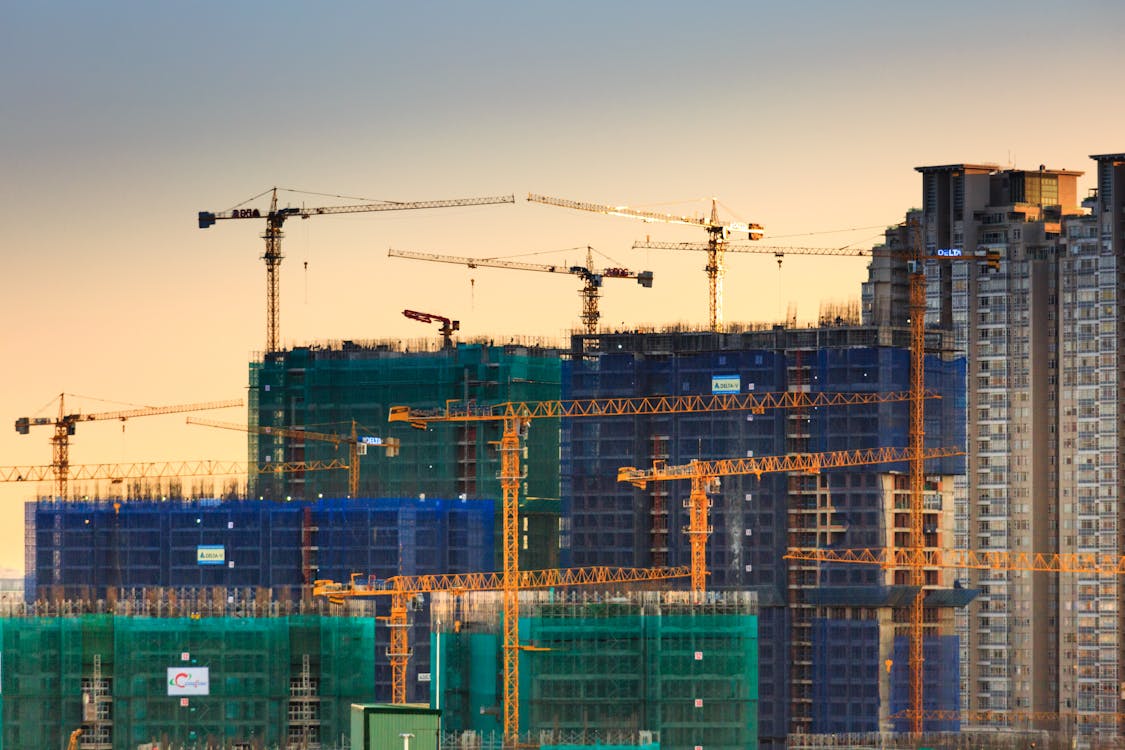Generally, Construction in COVID-19 | it is said that as you hit rock bottom, the only place where you can go from there is up. Similarly, the economy has suffered so badly during covid-19 that a small increase looks gigantic and promising. A post covid outlook of the economy is positive as unemployment is declining, people are starting to spend more, and the world is coming back to normal, at least trying to.
Similarly, the constructions sector is showing signs of growth in the post-Covid scenario. In the pacific northwest, the construction industry has added 110,000 jobs in march. this means that the construction industry has recovered more than 80% of the jobs lost in the pandemic in this region.
The calm before the storm: Situation of the construction industry (in the Pacific Northwest region) before the outbreak of the pandemic
The engineering, construction, and building material (ECB) performance was not commendable even before COVID 19. ECB companies were suffering from low productivity, neglecting digitization. However, since 2015 the industry has been a force to innovate sustainability, production approaches, and embracing digitization. For instance, the research and development(R&D) spending in the top 2500 construction companies in North America has increased by 82% in the last six years.
The covid-19 had only uncovered the vulnerabilities in the construction industry. As soon as covid-19 started to take the shape of a pandemic, projects started getting delayed, the supply chain came under immense pressure, and labor began to disappear as unemployment rose. The restrictions like social distancing at sites and lockdown further worsened the crisis.
Why is the resurgence of the construction industry essential?
Connect One bank considers construction as a key component of economic success. According to a report, new home construction has a three times multiplier effect on the United States’ GDP. An estimate suggests that every dollar spends on new home construction brings back 3 dollars into the economy.
-
The construction industry needs to resurrect to meet the high demand
Freddie Mac found out in the latest analysis that approximately 4 million new houses will be required to fulfill future requests for residential homes. It presents an opportunity for local builders. Therefore, construction industry needs to resurrect to meet the current and future demand.
-
Digitization of construction industry: A challenge in the post-pandemic world
The resurgence of the construction industry does not mean only increasing the volume. It refers to embracing technology, innovation, and digitization.
By 2025, the global population is expected to reach approximately 9 billion. The construction industry won’t keep up with this pace if the industry ignores digitization and innovation. On the other hand, the rising cost of the material squeezes construction firms’ profit margins. Firms can only optimize their profit by targeting optimum efficiency and productivity in the planning phase. For example, prefabrication helps to reduce waste and creates room for increased predictability. Similarly, cost-scheduling serves as a precursor to accuracy in designing and implementing a structure.
Furthermore, efficiency can’t be viewed in singular while ignoring the importance of sustainability. Construction along with real estate produces one-third of CO2. However, some companies are leading the ways to reduce carbon emission as Autodesk is now ranked among the top 100 most sustainable companies.
How the construction industry can bounce back in the post-pandemic world: A case study of Haselden Construction, Primus Builders, Al Fara’a Group
The following analysis is based on a report published regarding in-depth- evaluation of more than 400 ECB companies, including Autodesk, Haselden Construction, Primus Builders, Al Fara’a Group. Furthermore, the coming paragraphs highlight how covid 19 has shifted the size and trends in the construction industry.
Long and short term trends in the construction industry in the light of covid-19
We may witness long and short terms effects of covid-19 in the construction sector. The new ways of living are setting up norms for the future.
-
Instant digitization
In the work-from-home scenario, the construction industry is moving rapidly towards embracing digitization and technology.
For example, designers focus more on digital collaboration through tools like building information modeling(BIM) and primavera. To re-optimize schedules, planners are using 4d and 5d modeling. Similarly, contracting are exploring digital means for procurement, check on their employees’ health.
-
Exploring alternatives
Contractors are rebalancing supply chains more towards resilience rather than efficiency. They are exploring alternatives by updating inventory, acquiring critical material first.
Long term trends
- Embracing technology, innovation, and digitization
Companies are looking forward to establishing economies of scale by encouraging critical investment in IT, supporting young talent, and R&D.
- Vertical integration to increase efficiency
Key players in the construction industry are already planning to integrate to increase efficiency and productivity vertically. Vertical integration may provide a means towards higher productivity in the post-Covid world. The new business models are structured around resilience and integrating forward in the value chain.
- Investing in technology and building systems
The construction industry is one such industry that has always suffered from a shortage of skilled laborers from the very start. With the restriction on traveling, the lack of skilled labor will become more severe. 4d simulation, digital workflow management, and real-time progress tracking will become even stronger. But construction industry will adapt to these changes successfully is a statement that requires contemplation. To speed up and automate processes of designing and scheduling, the industry needs to increase R&D spending.
- Constructing in a controlled environment
In the long-run construction industry needs to focus more on off-site construction. Off-site construction makes sense in the new world where workforces’ management, movement, and interaction are limited. In such a case, prefabricated structures will acquire preference.
- A march towards sustainability
Environmental considerations were often compromised in the world before covid-19. In the post-covid world, leaders must align sustainability and progress. It is a good chance for governments to set and meet realistic carbon reduction targets. For example, they are retrofitting housing stock to improve energy efficiency. These processes require public involvement, investment, and commitment. The world expects to see a rise in the demand for sustainable construction that promotes a healthier environment.
- Action plan for the future
Many executives are already strategizing initiatives to reshape their operating procedures and focusing on positive changes in the wake of the pandemic. There are the following action plants that will help companies to think proactively and reshape the future.
- Invest in building skills of the workforce
Maintaining a balance between health and performance is essential for achieving long-term success. Leaders must strive to clear the apprehensions related to job security and productivity. Furthermore, cultural barriers always act as an impediment to high productivity.
- Promote remote collaboration and digitization
Already there is a lot of time lost due to the pandemic; therefore, there is no time to devise a roadmap. Contractors must look forward to scaling up remote collaboration at the early stages of a project that will allow minimal human resources at the site. Similarly, distributors need to look beyond limited options and explore the potential of eCommerce in the construction industry. Moreover, consultants need to strengthen their command over BIM tools.
- Focus on customers’ preferences
The pandemic has caused a vital shift in customers’ preferences, specifically online retailing, remote working, and sustainability. Chances of emergence new conflicts are there; therefore, companies need to stay close to customers.
How next normal will look for the construction sector: 5 R’s
It is clear as daylight that the world is completely different after the pandemic. Industry leaders must take it as an opportunity to rework their strategies and align their goals with future requirements. ECB’s resurgence lies in 5 horizons: resilience, Reimagination, return, resolve, and reform.
First of all, resolve requires leaders to address immediate challenges posted by covid-19.
Secondly, resilience correlates with short-term financial challenges and effects related to virus-related lockdown.
Thirdly, focus on returning to normal and scale businesses accordingly.
Next, Reimagination will help companies return to the drawing board and plan about the next normal.
Lastly, the reform process focuses on realigning the company’s strategy to a competitive world.
Seeing how top companies like Haselden Construction responded to the crisis; we can draw two outcomes. First companies’ focused on resolving immediate repercussions and second-leading companies focused on building resilience.
In the northwest pacific region, we have witnessed that sites are starting to reopen but are still in the recovery phase. The process of coming back on track requires a balanced approach, showing compliance with the local regulations, and managing clients and supplier’s relationships.
As a response, construction companies are taking rigorous steps to take their companies beyond crisis. Companies are reshaping their procedures, launching ambitious initiatives to emerge stronger from the crisis. A healthy emerging ECB industry is essential for an immediate crisis response, which ensures complete economic recovery.
It won’t be wrong if we say that the engineering and construction industry is standing at an inflection point. Emerging markets, smart cities, stringent covid-induced restrictions are pushing companies to adapt to disruptions caused by the pandemic.
The word is marred with uncertainty; the company’s client base, competitive advantage, and supply chain will have a completely different look once the pandemic is over completely. It is difficult to foresee what exactly lies ahead.
We have discussed various models that may help the construction industry to recover faster than anticipated. Yet, these models need clarity regarding the E&C marketplace, supply chain, and cost containment.
There is a lot to be optimistic about in the post-pandemic world. The post-pandemic world has opened up new avenues for construction companies to innovate and digitize. The demographics of the construction industry will change in the post-pandemic world as a fair number of Americans have relocated, and many companies have relocated as well. Ultimately along with wreaking havoc across the globe, the COVID 19 is leaving us with a ray of hope that we can build a better future on the foundations of sustainability, innovation, and productivity.
In a nutshell, the pandemic is a golden opportunity for the construction sector to take an innovative leap and not just recover from the crisis but move forward. The industry must pragmatically tackle all the historical issues that have held back the whole sector’s progress. This time is challenging, but it is also an opportunity. Let us not waste it.
JHELMY and Co. will help your company to transform and recover from the effects of the COVID-19. We can help you to strategize and plan for the next normal by keeping the future demand in mind. Furthermore it will help your company’s strategy to realign with the competitive world by incorporating automation, innovation and special focus on BIM technology incorporation.

